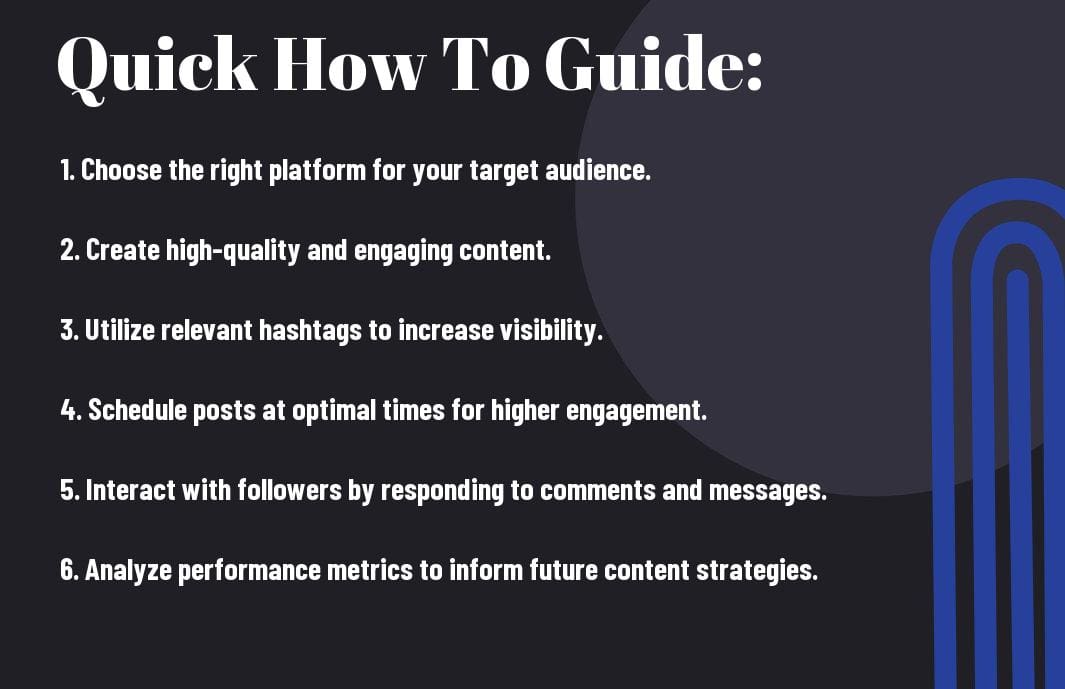Publishing compelling and engaging content on social media is crucial for businesses and individuals looking to build a strong online presence. Knowing how to effectively publish content can make or break your success in the digital world. In this comprehensive guide, we will walk you through step-by-step instructions on how to optimize your content publishing strategy for various social media platforms. From creating eye-catching visuals to crafting captivating captions, you will learn the best practices to maximize your reach and engagement online. Stay ahead of the competition by mastering the art of content publishing on social media with our expert insights and tips.
Key Takeaways:
- Consistency is key: Regularly publishing content on social media helps keep your audience engaged and informed. Establishing a content calendar can help you stay organized and consistent with your posts.
- Engage with your audience: Responding to comments, messages, and mentions on social media can help you build a stronger connection with your followers. Encourage discussions and ask for feedback to increase engagement.
- Use analytics to track performance: Monitoring the performance of your content on social media can provide valuable insights into what works best for your audience. Utilize analytics tools to track metrics such as reach, engagement, and conversions.


Setting Up for Success
Understanding Your Audience
Little is more crucial to successful content publishing on social media than understanding your audience. Take the time to research and analyze who your target audience is, what they like, their interests, and the type of content they engage with the most. By understanding your audience, you can tailor your content to their preferences, increasing the chances of engagement and interaction.
Choosing the Right Platforms
One of the key steps in content publishing on social media is choosing the right platforms to showcase your content. You need to identify which platforms are most popular among your target audience and where they are most active. By focusing your efforts on the platforms where your audience spends the most time, you can maximize your reach and engagement.
You need to consider the demographics, interests, and behaviors of your audience when choosing the right platforms. For example, if your target audience is primarily younger, you might want to focus on platforms like Instagram and TikTok. If your audience is more professional, platforms like LinkedIn might be more suitable for your content.
Creating a Content Calendar
To ensure a consistent and organized approach to content publishing on social media, you need to create a content calendar. This calendar should include a schedule of when and what type of content you will be posting on each platform. By planning ahead, you can maintain a regular posting schedule, stay ahead of important events or holidays, and ensure that your content is varied and engaging.
When creating a content calendar, consider the best times to post on each platform, the frequency of your posts, and the themes or topics you want to cover. This will help you stay organized and focused on creating content that resonates with your audience.
How-To Create Captivating Content
Tips for Crafting Engaging Posts
Not all content is created equal when it comes to social media. To grab your audience’s attention and keep them engaged, you need to follow some key tips for crafting engaging posts. Utilize strong visuals, ask questions to encourage interaction, keep your captions concise and impactful, and use relevant hashtags to increase visibility. Recognizing what resonates with your audience and adapting your content accordingly is crucial for success.
Utilizing Visuals Effectively
While text is important, visuals play a significant role in capturing your audience’s attention on social media. Utilizing eye-catching images, videos, infographics, and gifs can help make your content more engaging and shareable. To stand out, create visually appealing content that is relevant to your brand and resonates with your target audience.
Writing Attention-Grabbing Headlines
Utilizing powerful, concise, and intriguing headlines can make a significant difference in the success of your social media content. Crafting headlines that are emotionally impactful, curiosity-inducing, and solution-oriented can compel users to click through and engage with your posts. By grabbing attention with your headlines, you increase the likelihood of your content being seen and shared.
Publishing and Promotion Techniques
Factors That Affect Posting Frequency
Your posting frequency on social media can be influenced by several factors. It’s imperative to consider your audience engagement, platform algorithms, and the type of content you share. Consistency is key to maintaining a loyal following and keeping your brand top of mind. Experiment with different frequencies and track the performance to determine the optimal posting schedule. Any changes should be gradual to avoid overwhelming or losing your audience.
Tips for Scheduling and Automation
An effective scheduling and automation strategy can save you time and ensure consistent posting. Use tools like Hootsuite or Buffer to schedule posts in advance based on your audience’s active times. Consider automating repetitive tasks such as sharing blog posts or responding to common queries. Assume that engagement is key in maintaining a human touch, so avoid fully automated interactions. Regularly review and adjust your scheduling strategy to optimize performance.
- Use scheduling tools like Hootsuite or Buffer.
- Automate repetitive tasks for efficiency.
- Maintain human engagement by avoiding full automation.
- Regularly review and adjust your scheduling strategy.
Amplifying Reach Through Paid Promotion
Promotion of your content through paid channels can significantly increase your reach and engagement. Platforms like Facebook and Instagram offer targeted advertising options to reach specific audiences based on demographics, interests, and behaviors. Promotion budgets can be adjusted to test different campaigns and optimize performance. Ensure that your promoted content aligns with your overall marketing goals to maximize the impact of paid promotion.
- Utilize targeted advertising options on platforms like Facebook and Instagram.
- Test different campaigns and adjust budgets for optimal performance.
- Align promoted content with overall marketing goals for maximum impact.
Measuring and Analyzing Results
Once again, one of the most crucial aspects of content publishing on social media is measuring and analyzing the results. Understanding how your content is performing can help you make informed decisions on how to improve and optimize your strategy.
How-To Track Performance Metrics
To track performance metrics effectively, you can use social media analytics tools provided by platforms like Facebook Insights, Google Analytics, and Sprout Social. These tools offer valuable data on engagement, reach, clicks, and conversions, allowing you to assess the effectiveness of your content strategy.
Tips for Adjusting Strategy Based on Analytics
For adjusting your strategy based on analytics, consider these tips:
- Identify top-performing content and replicate its success.
- Monitor audience engagement and adjust posting times accordingly.
- Experiment with different content formats to see what resonates with your audience.
With these tips in mind, you can optimize your social media strategy for better performance and results. This will help you create content that is not only engaging but also drives meaningful outcomes for your brand.
FAQ
Q: Why is content publishing important on social media platforms?
A: Content publishing on social media platforms is crucial for businesses and individuals to attract and engage with their target audience. It helps in building brand awareness, driving website traffic, generating leads, and ultimately increasing sales and revenue.
Q: What are some best practices for content publishing on social media?
A: Some best practices for content publishing on social media include creating a content calendar, identifying the target audience, using engaging visuals and videos, posting consistently, engaging with followers, analyzing performance metrics, and staying up-to-date with platform algorithms and trends.
Q: How can one measure the effectiveness of content publishing on social media?
A: The effectiveness of content publishing on social media can be measured through key performance indicators (KPIs) such as likes, shares, comments, website traffic, conversion rates, follower growth, click-through rates, and engagement rates. It is important to track these metrics regularly and make data-driven decisions to optimize content strategy.




